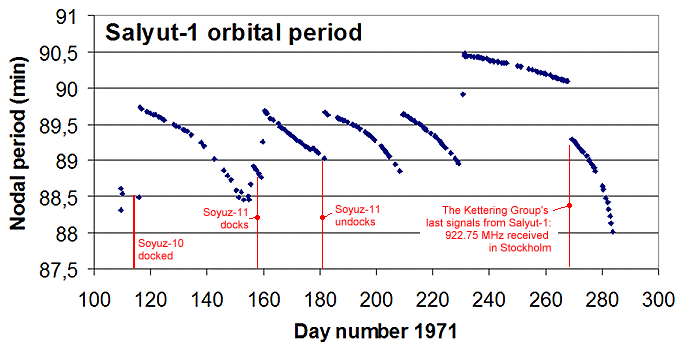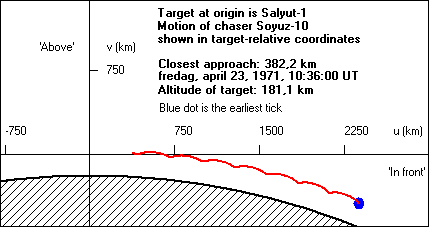
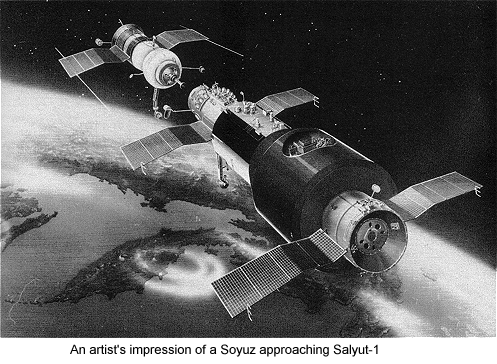 The
description given by Boris Chertok
(4) (8)
of how the DOS (Dolgovremennaya Orbitalnaya Stanziya =
Long-duration
Orbital Station) space station program was created is fascinating. One
can easily imagine the frustration felt by the TsKBEM leadership
(TsKBEM
was the then valid name for Korolev's organization formerly known as
OKB-1)
after the Soyuz-6/7/8 flight. The N1-L3 program was in deep trouble
after
two failures and there was no clear use for the Soyuz - the only
working
manned spacecraft. In addition, their competition, OKB-52 under
Vladimir
Chelomey, was working on a high profile program - the military space
station
Almaz (a.k.a. OPS) - where TsKBEM had no role.
The
description given by Boris Chertok
(4) (8)
of how the DOS (Dolgovremennaya Orbitalnaya Stanziya =
Long-duration
Orbital Station) space station program was created is fascinating. One
can easily imagine the frustration felt by the TsKBEM leadership
(TsKBEM
was the then valid name for Korolev's organization formerly known as
OKB-1)
after the Soyuz-6/7/8 flight. The N1-L3 program was in deep trouble
after
two failures and there was no clear use for the Soyuz - the only
working
manned spacecraft. In addition, their competition, OKB-52 under
Vladimir
Chelomey, was working on a high profile program - the military space
station
Almaz (a.k.a. OPS) - where TsKBEM had no role.
At the end of 1968 the basic space station structures were being readied at the end of 1968 in the Khrunichev factory in Fili. Chertok says that for OKB-23, the subsidiary of OKB-52, it was not a difficult task to design the hulls of the OPS. The space station OPS was developed for the defense ministry as a manned reconnaissance satellite with development of the photo film onboard and TV transmission of selected pictures. The OPS Almaz design included the use of gyrodynes (similar to control moment gyros) and other novel features like a real onboard computer "Argon", much later to be included in "Mir".
The first stirrings concerning TsKBEM's role in a space station program took place in August 1969 in Chertok's office after a long discussion about the flight plan for Soyuz-6/7/8. Raushenbakh (11), Legostayev and Bachkin proposed a whirlwind program to overtake Almaz. The original idea was to take a section of the hull of an R-7 rocket and equip it with Soyuz subsystems to form a space station. As subsystem by subsystem was examined it was clear that perhaps a mixture between Soyuz and Almaz subsystems may do the trick. That is how the idea of outfitting Almaz hulls with Soyuz subsystems was born within a tight group of "conspirators" with Konstantin Feoktistov (9) as the driving force.
After the semi-successful flight of the Soyuz "troika" in October 1969 the group met again in Bushuyev's office at TsKBEM to plot strategy. It is noteworthy that this plot was stepped up in intensity when V.P. Mishin (10), the head of TsKBEM was on holiday in Kislovodsk. Even Chertok finds it difficult to remember how Dimitri Ustinov (6) got wind of the idea and decided to meet with Chertok, Bushuyev (7), Feoktistov, Raushenbakh and Ochkapin (12) soon after Mishin's departure for Kislovodsk. One of the representatives for the defense department of the Central Committee, Krazavsev, had been secretly briefed by Bushuyev about the "conspiracy". The Central Committee, it seems, was well aware that Almaz would not fly in at least two years (three and a half as it turned out) and that it was intended as a secret project. The political leadership of the space program realized that they needed a cover for Almaz and the project proposed by the TsKBEM could provide just that. In the meeting Feoktistov spoke first and explained that by combining the hulls of Almaz with Soyuz derived subsystems a space station could be put into orbit in a year's time! The leadership asked if this plan could be carried out without adversely affecting the manned lunar landing project N1-L3 and were (probably erroneously) assured that this was not the case. The meeting ended with the message that a decision would be worked out to be submitted to the Military-Industrial-Commission and to be decided by the Central Committee in January 1970.
Inside TsKBEM it was decided to move Yuri Semenov, the present head of RKK Energia (successor organization to TsKBEM) from the 7K-L1 Zond program to become head of the space station effort - DOS. On 26 December 1969 a meeting was called by Ustinov at Kuybyshev Street with representatives of TsKBEM and the developers of Almaz to mobilize forces around the new space station initiative. TsKBEM now promised to complete the project in one and a half year. The final decrees initiating DOS 'On creation of the DOS using Almaz as a basis' were issued on 9 and 16 February 1970. The crash project to develop 17K-DOS began.
On 15 February Ustinov had presented plans to the Soviet. It was agreed that work would continue on both the N1-L3 lunar expedition and DOS. On 5 May 1970 Smirnov and Afanasyev set the course of manned space flight at a project review for DOS. Almaz and DOS would continue in the short term and later a much more ambitious space station denoted MKBS would follow. An attempt by Mishin to replace Almaz with something called DOS-A was rejected.
Work on the DOS station had begun in February 1970 using Almaz # 121 and 122. In all honesty, DOS was simpler to build than Almaz with its very sophisticated payload. However, extensive modifications were needed to convert Almaz into DOS. This was mainly done by adding parts to the basic Almaz structure:
The TsKBEM plot to "kidnap" the space station program was brilliant! Almaz was much delayed and promised no immediate response to Apollo. TsKBEM promised to achieve quick results and put a space station in orbit very soon by using Soyuz technology in most subsystems. It still intrigues me how they were able to pull that thing off in 16 months! Of course the DOS decision was very much motivated by the political need to produce quick results to compensate for the fact that Soviet astronautics had nothing to show the world that could match Apollo. N1-L3 was stalled and 7K-L1, the circumlunar manned flight, was made obsolete by Apollo-8 a year earlier. Also, Almaz was a secret project and could not be used for propaganda. The time for DOS was ripe.
I note with some
satisfaction
from Chertok's account
(4) that the political
leadership of the space program realized that they needed a cover for
Almaz
and DOS could provide just that. There was a serious attempt to confuse
the general public in naming both space station types Salyut, but
little
did the political levels realize how easy it was to spot the difference
between OPS and DOS: radio signals, orbit altitude, crew composition! I
take some pride in being the first to publish (5)
the results of radio
tracking showing that there were two Soviet space station programs.
I heard about the launch on the radio a little more than four hours later at 0600 UT while putting on full battle uniform in the Signal Corps barracks in Uppsala, Sweden. My company was leaving the base for a two-day guerilla warfare exercise - sleeping out in the open etc. When I returned totally exhausted from the depths of the vast forests in the northern part of the county of Uppland on Wednesday 21 April I had caught pneumonia. I was taken into the base hospital the following morning with a high temperature. On Friday morning (23 April) I heard about the launch of Soyuz-10 towards Salyut-1 on the radio in the hospital ward. Imagine, being caught in an army hospital when the manned space station era began! I couldn't have been more frustrated!
Soyuz-10 (7K-T #31) was launched at 2354.06 UT on Thursday 22 April 1971 from launch Complex 1. The radio call sign of the crew was "Granit".
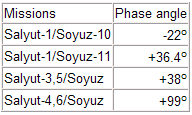 Soyuz-10
made an unusual approach to Salyut-1 compared to later rendezvous
operations.
Instead of chasing the space station from a lower orbit it was placed
in
front of and above Salyut-1 at launch. If the phase angle between the
target
and the active vehicle is defined positive when the target is ahead the
table on the right can demonstrate the differences between various
Salyut
approaches:
Soyuz-10
made an unusual approach to Salyut-1 compared to later rendezvous
operations.
Instead of chasing the space station from a lower orbit it was placed
in
front of and above Salyut-1 at launch. If the phase angle between the
target
and the active vehicle is defined positive when the target is ahead the
table on the right can demonstrate the differences between various
Salyut
approaches:
The reason for this modus operandi of Soyuz-10 is quite obvious if one looks at the orbital geometry of Salyut-1. Its ground track was almost stabilized around 348.5 degrees West northbound equator crossing longitude for the orbit passing closest to the launch site on the day of launch of Soyuz-10. The reason for this was that the initial period of the station around 88.6 minutes dropped down through the value for a 16-revolution repeating ground track (occurs at 88.39 minutes). Since the initial northbound equator crossing longitude of a Soyuz is about 347.2 degrees West it was necessary to let the Soyuz be ((348.42-347.2)/15)*88.4=7.2 minutes (corresponding to 7.2*60*8 = 3456 km) ahead of Salyut in order to have co-planar orbits. Why the launch of Soyuz-10 could not be delayed a few days to permit a maneuver to raise the orbit of Salyut-1 to a safe level where the risk of immediate decay was minimal. By using the available orbital data for Soyuz-10 and Salyut-1 we can draw a graph of the relative motion of Soyuz-10 relative to Salyut-1 from the moment of orbital injection until the time of the first orbit correction at 1035 UT on 23 April. At that point the two craft were approaching rapidly and the orbit of Soyuz-10 needed badly to be lowered to reduce the closing rate for a rendezvous the following morning. As can be seen from this graph the relative distance at injection agrees relatively well with the calculation above. The orbital data are probably somewhat inaccurate, especially the drag parameters.

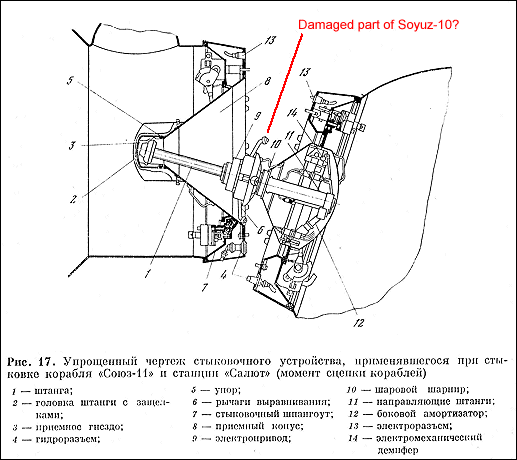 The
original plan was for Soyuz-10 to make an orbit correction, as per
standard
operating procedure, on revolution 5, but was not performed. The same
happened
on the next orbit. The reason the first time was that there was some
kind
of error in the programming logic for the command. The reason for the
second
delay in the correction was that the cosmonauts were given the data for
the correction maneuver very late and did not have the time to enter it
into the keyboard on the instrument panel. The reason for the late
arrival
of maneuver data could have been caused by the need to collect much
radar
tracking data of the rapidly decaying orbit. Also, it seems that the
ionic
orientation system malfunctioned (22).
Finally the maneuver was made manually at about 1035 UT and the impulse
lasted 17 seconds (21).
The
original plan was for Soyuz-10 to make an orbit correction, as per
standard
operating procedure, on revolution 5, but was not performed. The same
happened
on the next orbit. The reason the first time was that there was some
kind
of error in the programming logic for the command. The reason for the
second
delay in the correction was that the cosmonauts were given the data for
the correction maneuver very late and did not have the time to enter it
into the keyboard on the instrument panel. The reason for the late
arrival
of maneuver data could have been caused by the need to collect much
radar
tracking data of the rapidly decaying orbit. Also, it seems that the
ionic
orientation system malfunctioned (22).
Finally the maneuver was made manually at about 1035 UT and the impulse
lasted 17 seconds (21).
During the approach of Soyuz-10 the leadership of the space program had gathered at Yevpatoria and Mishin and Kerimov (24) were worrying about what would happen if Igla did not work. During the approach phase the Saturn radar station (at Baikonur?) experienced problems. Despite all this excitement and worry the crew reported that Igla had locked on to salyut-1 at a range of 10 kilometers. The mission director, Agadshanov, had a hard time keeping the present politicians and high leaders informed, the crew up-to-date and all elements of the operations coordinated. Raushenbakh whispered to Chertok "This is a madhouse. I hope Igla remains sane!" The cosmonauts were also excited. As the spacecraft passed directly over Yevpatoria the telemetry station at 0111 UT reported that Shatalov's and Yeliseyev's pulses were at 100 and Rukavishnikov's 90. The two craft left the zone of visibility from tracking stations when the distance was 800 meters. An hour's radio silence followed.
When the crew came within view of tracking stations in western Russia at about 0235 UT the crew reported the docking contact to have occurred at 0147 UT using manual control, but that 9 minutes into the coupling process it had been interrupted. There was a gap of 90 millimeters between the docking collars of the two craft. The crew also reported large attitude movements directly after capture of the docking probe on Soyuz-10 by the docking cone on Salyut-1. Attitude control thrusters had fired for 30 seconds. Immediately it was suspected that the guide arms on the side of the docking probe had been overloaded and broken (see picture above. There is a larger version of this sketch available here). The attitude thrusters should not have fired - the rate gyros were confused at the docking contact. It was soon deemed impossible to achieve a "hard dock" and the emphasis was now put on how to undock. This was not easy to do. Normally the undock procedure required that "hard dock" had been achieved. Since this was not the case other methods were needed. There was an emergency method in which a pyro device would sever the docking probe from Soyuz, but the remainder of the probe would stay attached to the docking cone of Salyut-1 preventing further dockings. There were ideas to bypass the circuitry in Soyuz that prevented the undock command to be sent. Two hours were spent on putting together the instructions how to do this and reading it to the crew. They were not enthusiastic. At that time someone remembered that it was possible to send a command to Salyut-1 to release the docking probe! For this to work it was necessary that the pressure on the locking device was not too high, a condition which would prevent the locking device to move. However, the craft were finally separated at 0717 UT!
The flight had been
intended
to last 30 days, permitting retrofire and landing in daylight. Now
these
events would take place in darkness and no visual cues would be
available
to correct the attitude of the spacecraft manually. Therefore the crew
was instructed to test a method whereby they would manually orient the
craft properly in daylight and then rely on integrating rate gyros to
maintain
the correct attitude until retrofire. Emergency landing places were of
course available (see separate
article)
but the procedure tested by Shatalov worked fine and the crew could
land
2340 UT 120 km northwest of Karaganda a few minutes before sunrise.
The diagram below shows the receptions by the Kettering Group of the two spacecraft on shortwaves during the complete Soyuz-10 mission (16). During the first day in orbit shortwave signaling started while the two craft were in the radio visibility from Soviet territory but most of the activity took place outside this zone. The following day, when Soyuz-10 docked and undocked shortwave signaling was almost exclusively limited to the zone outside direct visibility from the Soviet Union. Interestingly Chris Wood at Fiji picked up signals on the recovery revolution.
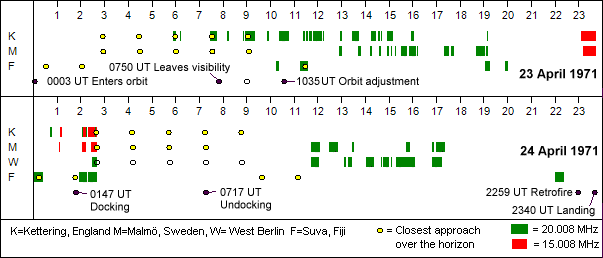
The prime crew (Leonov, Kubasov, Kolodin) was replaced just four days before launch with the back-up crew Dobrovolski, Volkov, and Patsayev. The reason was that Kubasov was suspected of having contracted tuberculosis after an X-ray on 3 June had revealed a dark spot on his right lung. Mission rules dictated that the entire crew be replaced. However, cosmonaut training chief Kamanin thought it was better to just replace Kubasov, because the back-up crew only had one experienced cosmonaut, Volkov. However, Kubasov's lung spot was benign and later he and Leonov trained for later Salyut missions, but when these DOS stations failed in various ways they were eventually reassigned to the Apollo-Soyuz Test Project.
Soyuz-11 (7K-T #32) was launched at 0455.09 UT on Sunday 6 June 1971. The crew's radio call-sign was "Yantar".
The docking time given in the literature is normally 0745 UT. One source gives the docking time as 0749 UT. Aviation Week says the Igla system was switched on at 0427 UT and that the craft had come within 10 meters 25 minutes later, i.e. 0452 UT (2). Chertok says that the permission to open the hatch between the craft was given at 0732.30 UT (3). Considering all this, I think the docking actually occurred at, say 0510 UT, over the Pacific, outside the visibility of ground stations in the Soviet Union. The actual entry into Salyut, I think, took place at 0745 UT. A maneuver to a higher orbit took place the following day, 8 June, at 0802 UT (2).
At this stage of the Salyut-1 mission it was estimated that fuel and supplies would last until 20 August and that the Soyuz-12 crew could be launched to the station in the time frame 15-20 July. The crew foreseen for this flight was Leonov, Rukavishnikov and Kolodin (23). This was almost the same crew as that intended for Soyuz-11 with the exception of Rukavshnikov from the Soyuz-10 mission. the reason for this crew choice was that the next crew in line (Gubarev, Sevastyanov and Voronov) had not been trained enough.
Just as for Soyuz-10 signaling on shortwaves was most intense when the craft was outside direct visibility from Soviet territory. After the docking on 7 June 1971 short-wave telemetry was intermittent and last signals for a period of nine days were picked up on 9 June.
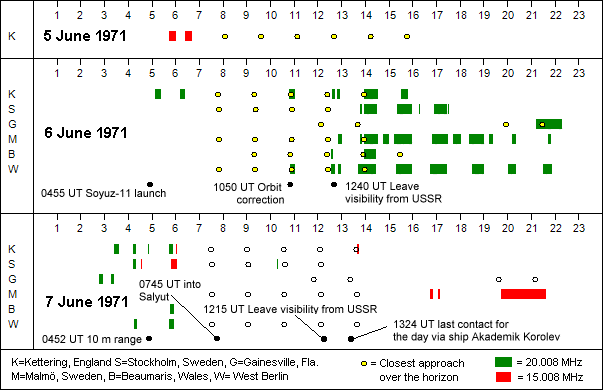
On 7 June, well after the docking, myself and Geoff Perry picked up a baffling series of hand-keyed transmissions on 20.008 MHz which we judged to have come from the newly occupied space station. The message, which contained several keying errors as if tapped out by an inexperienced operator was (after corrections have been entered) "...PONYAL KAK PONYAL VVV PONYAL PONYAL WAS PONYAL T PRINYAL...", which is a round-about way of saying "I received your message". A longer account of how to interpret these transmissions can be found in a separate article.
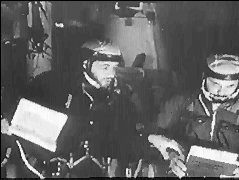 On
16 June the crew (see picture on the right. Credit: Mark Wade's
Encyclopedia
Astronautica) reported that there was strong smell of smoke from fire
aboard
the space station . Actually there was a smell as from burned
electrical
insulation and some smoke came from a control panel for scientific
instruments.
As Chertok describes it (14), when
reporting
the incident to earth, the cosmonaut on duty, Volkov, used the code word
"curtain" for smoke or fire. But mission control at Yevpatoria had
forgotten what the code word meant and started asking questions like
"what
kind of curtain?". Finally Volkov cursed and said in plain language:
"There
is a fire on board. We will transfer to the transport ship". Volkov
also
said they could not find the check list for emergency evacuation of the
space station. Mission control gave them extensive page references.
Mission
control also explained that the decision to evacuate would be taken by
the commander onboard. Finally the commander Dobrovolski came on line
and
explained that they had decided not to make any hasty decisions. The
suspect
unit had been switched off and Volkov was sent to rest while
Dobrovolski
and Patsayev took over. This was the normal cycle of work on the
station;
one asleep the other two on duty. Later on it was clear that Volkov had
calmed down and the mission continued. June 17 was made into a rest day
for the crew.
On
16 June the crew (see picture on the right. Credit: Mark Wade's
Encyclopedia
Astronautica) reported that there was strong smell of smoke from fire
aboard
the space station . Actually there was a smell as from burned
electrical
insulation and some smoke came from a control panel for scientific
instruments.
As Chertok describes it (14), when
reporting
the incident to earth, the cosmonaut on duty, Volkov, used the code word
"curtain" for smoke or fire. But mission control at Yevpatoria had
forgotten what the code word meant and started asking questions like
"what
kind of curtain?". Finally Volkov cursed and said in plain language:
"There
is a fire on board. We will transfer to the transport ship". Volkov
also
said they could not find the check list for emergency evacuation of the
space station. Mission control gave them extensive page references.
Mission
control also explained that the decision to evacuate would be taken by
the commander onboard. Finally the commander Dobrovolski came on line
and
explained that they had decided not to make any hasty decisions. The
suspect
unit had been switched off and Volkov was sent to rest while
Dobrovolski
and Patsayev took over. This was the normal cycle of work on the
station;
one asleep the other two on duty. Later on it was clear that Volkov had
calmed down and the mission continued. June 17 was made into a rest day
for the crew.
Clearly Volkov's transmissions in the clear about a fire were picked up by Western COMINT monitoring stations. And, indeed there were rumors in the West during the 1970's about this incident. Indeed, it is instructive to red the following passage from Charles Sheldon's' report about Soviet space activities to the US Senate (15). What is Dr Sheldon trying to tell the reader?:
".. When looking at the table of daily activities, an intriguing change in the routine occurs on June 17. The Soviet press gave no reports of scientific work or television transmissions, but only mentioned 'minor correction work', adding that the ship was equipped with tools, spare parts and safety devices. On June 18 the routine returned to normal, but G.E. Perry of the Kettering Grammar School in England detected telemetry transmissions on the Soyuz-11 frequency. This might have signaled that the trouble of the day before was forcing an early return, but the mission continued. ...".No signals had been heard on shortwaves from either Soyuz-11 or Salyut-1 since 9 June and during the period 18-21 June shortwave signaling was intensive to be followed by near silence (one short transmission from Soyuz on 24 June and one from Salyut on 26 June) until one day before landing when transmissions on 20.008 MHz from Soyuz resumed (16).
As it turned out what happened during the fire incident was typical of the situation among the crew where Volkov, as the only experienced cosmonaut, insisted that all decisions should be taken "collectively" and perhaps saw himself as the de facto commander.
"I picked up my first signals for over 7 days on 28 June around 2110 UT - Salyut on 20.008 MHz and assumed that recovery would take place on 29 June around 2000 UT. Consequently I set the alarm clock for 3.a.m. BST hoping to see two objects indicating that Soyuz-11 had separated from Salyut but that was not to be. We had no signals during 29 June and when 2000 UT came and went I went off watch, but, fortunately, left the time switch to do the pass at 2230 and 0300 UT. I did not believe that the Russians would worry about a recovery in darkness at this time of the year, considering their usual precision landings.However, they did worry and Soyuz-11 went two extra revs to give a daylight recovery. The time switch recorded signals 45 s after it had operated with LOS at 2247:15 +/- 15 s (allowing for possible variations in mains frequency affecting the clockwork). Peter Bentley had banked on a daylight recovery and was listening at Menai Bridge and gives LOS at 2247:27 +/- 1 s (or, as he says, +/- 5 s for 99% accuracy). I have therefore adopted 2247:25 +/- 5 s as LOS and the time of separation of the descent module and instrument module. The tragedy must have occurred minutes, or even only seconds, later. Telemetry at LOS was normal for a Soyuz recovery".
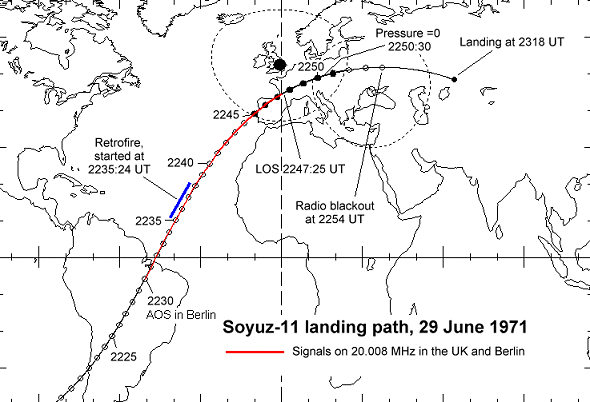 Interestingly,
the Soviet official time of separation (revealed many years later) is
2247:28
UT (19). The map shows the receptions by
the Kettering Group during this fateful evening and other related
flight
events (20). The Soviet account of the
disaster
is given in an official source (17):
Interestingly,
the Soviet official time of separation (revealed many years later) is
2247:28
UT (19). The map shows the receptions by
the Kettering Group during this fateful evening and other related
flight
events (20). The Soviet account of the
disaster
is given in an official source (17):
"At approximately 723 seconds after retrofire, the 12 Soyuz pyro cartridges fired simultaneously instead of sequentially to separate the two modules .... the force of the discharge caused the internal mechanism of the pressure equalization valve to release a seal that was usually discarded pyrotechnically much later to adjust the cabin pressure automatically. When the valve opened at a height of 168 kilometers the gradual but steady loss of pressure was fatal to the crew within about 30 seconds. By 935 seconds after retrofire, the cabin pressure had dropped to zero....... ...only trough analysis of telemetry records of the attitude control system thruster firings that ahd been made to counteract the force of the escaping gases and through the pyrotechnic powder traces found in the throat of the pressure equalization valve were Soviet specialists able to determine that the valve had malfunctioned and had been the sole cause of the deaths."
Aviation Week also reported in 1974 that the crew had tried to close a backup valve but had not been able to turn the hand crank valve fast enough. In James Oberg's book (18) he relays a rumor that an indication of the leak had been received on the Soyuz instrument panel upon casting off from the Salyut, but that instead of redocking and analyzing the possible problem the crew had been ordered by General Kamanin to proceed with the landing and ignore the leak indication. This turns out to be a somewhat distorted version of actual events where the indicator light showing that the hatch between the descent and orbital modules was open refused to go off. It seems that the indicator switch was slightly out of position and by placing an object in front of it the indicator light went off (19). The Soyuz finally undocked from Salyut-1 at 1825:15 UT while over the Yeniseysk ground station in Siberia.
In (19) we learn that the crew noticed a leak immediately, probably from the hissing noise it generated, rushed to the front hatch thinking that this earlier problem was related to the sound. To locate the source of the noise the crew turned off all radios. They probably located the leaking valve under one of the seats and tried to close it manually. All this must have happened very quickly, possibly in less than 20 seconds because that is how long the crew would have remained capable of work after the start of the leak. Two minutes after the start of the leak the pressure had dropped to zero and the crew were dead. In (19) we also learn that the valve in question was not a pressure equalization valve but a fresh air valve to be opened after landing,
The detailed information in (19) and (17) could not have been obtained through telemetry, because after separation from the service module there is no telemetry transmission from the descent module. Telemetry is recorded onboard. In the case of Soyuz-11 there was a recording device called "Mir" (19). We know that in the Soyuz TM descent vehicle there is a data recorder called "Mir-3A-1" capable of recording up to 64 analog channels at a sampling rate of 31.25 Hz and 128 on-off channels. The recording time is 76 minutes.
After service module
separation
the Soyuz VHF voice system normally starts transmitting "AN" morse code
signals on the standard 121.75 MHz FM voice link. On the present Soyuz
TM design the antenna for this link is a slot antenna located in the
lid
of the crew ingress/egress hatch at the top of the capsule.
Whenever
a cosmonaut wishes to talk to the ground he presses his microphone
button
and the Morse code signal is interrupted. Uplink to the re-entry
vehicle
is on 130.167 MHz as usual. When the parachute has been deployed
the system switches to 121.5 MHz AM for the down link and 130.167 MHz
AM
for the uplink. This switch of modulation type is consistent with
operation
with standard international search-and-rescue radios 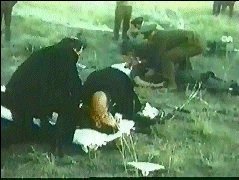 that
operate on AM. Indeed the frequencies used are in the aircraft band
where
AM is used. The "AN" message repeats three times in ten seconds and
followed
by a 15 second pause. (Listen to simulated
AN signal). After parachute deployment AN beacon signals are
also
transmitted as CW keyed signals on 8.364 MHz and 18.060 MHz.
that
operate on AM. Indeed the frequencies used are in the aircraft band
where
AM is used. The "AN" message repeats three times in ten seconds and
followed
by a 15 second pause. (Listen to simulated
AN signal). After parachute deployment AN beacon signals are
also
transmitted as CW keyed signals on 8.364 MHz and 18.060 MHz.
Ground control probably
wondered
why nothing was heard from the Soyuz-11 crew during descent. At
separation
from the orbital and service modules the descent vehicle was out of
range
from Soviet ground stations. However, two minutes later, by the time
the
pressure had dropped to zero the descent vehicle was over the horizon
at
Yevpatoria and there would be another 3 minutes until radio blackout.
Nothing
was heard from the crew during this period of course but, despite this,
the rescue crews were probably completely unprepared by what they saw
when
they opened the capsule after landing. The descent vehicle landed at
2318
UT at a spot 202 km east of Dzhezkazgan in Kazakhstan and after finding
the crew lifeless in the capsule attempts by rescue crews to revive the
crew were all in vain (see picture on the right. Credit: Mark Wade's
Encyclopedia
Astronautica). Thus ended a very tragic episode in the Soviet space
program.
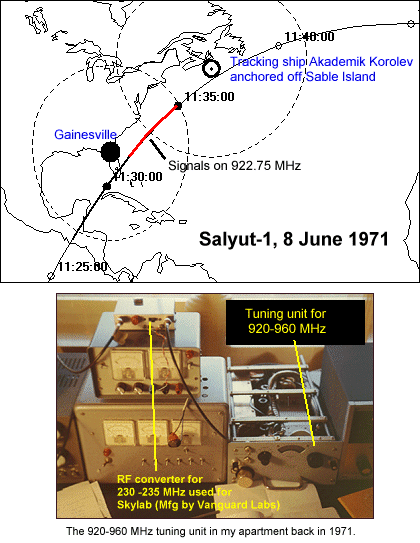 Tracking
Salyut-1 on 922.75 MHz
Tracking
Salyut-1 on 922.75 MHz"This morning at 1132 UT I received strong signals on 922.75 MHz from the Soviet space lab. The Doppler shift was fantastic - amounting to almost 40 kHz. The signal was just a beacon - no apparent modulation. But it was there - beautiful and strong. A very exciting moment indeed! Thank you so much for your information regarding frequencies which made it possible. I finished your unit Sunday afternoon and had planned to ship it yesterday but I must confess I spent all of yesterday getting my system finished".Dick's setup during this reception was quite simple. the helix antenna was propped up against a chair. My tuning unit finally arrived later in June and on 25 September, just after the big maneuver down (see below) in preparation for de-orbiting the station, I picked up signals on 922.75 MHz from my apartment just outside Stockholm. That was the last that was heard of Salyut-1. I still have the tuning unit and it still works. I use it off and on to pick up signals from Soyuz and Progress vehicles on the very same frequency!
There is an interesting feature in this graph. The rate of decay of the orbit increases with lower orbital period, except for the period when Soyuz-11 was docked to Salyut-1. During that period the rate of decay instead decreased when period and altitude decreased. This behavior is unusual. Can it be explained by assuming that the whole combined vehicle moved in orbit "like an airplane", i.e. with solar panels in the local horizontal pane and the longitudinal axis pointing in the direction of orbital motion? In that way, the solar panels could provide a small amount of lift, that would increase as air density increased with decreasing altitude. During other mission phases the orientation must have been "random" in relation to the velocity vector.
